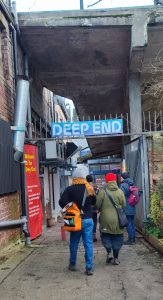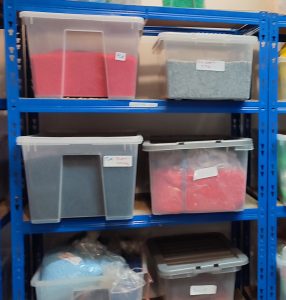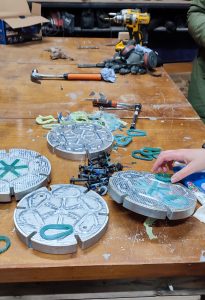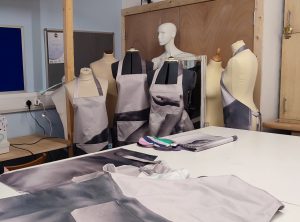21 Jan Crafting the commons and/or designing the commons?
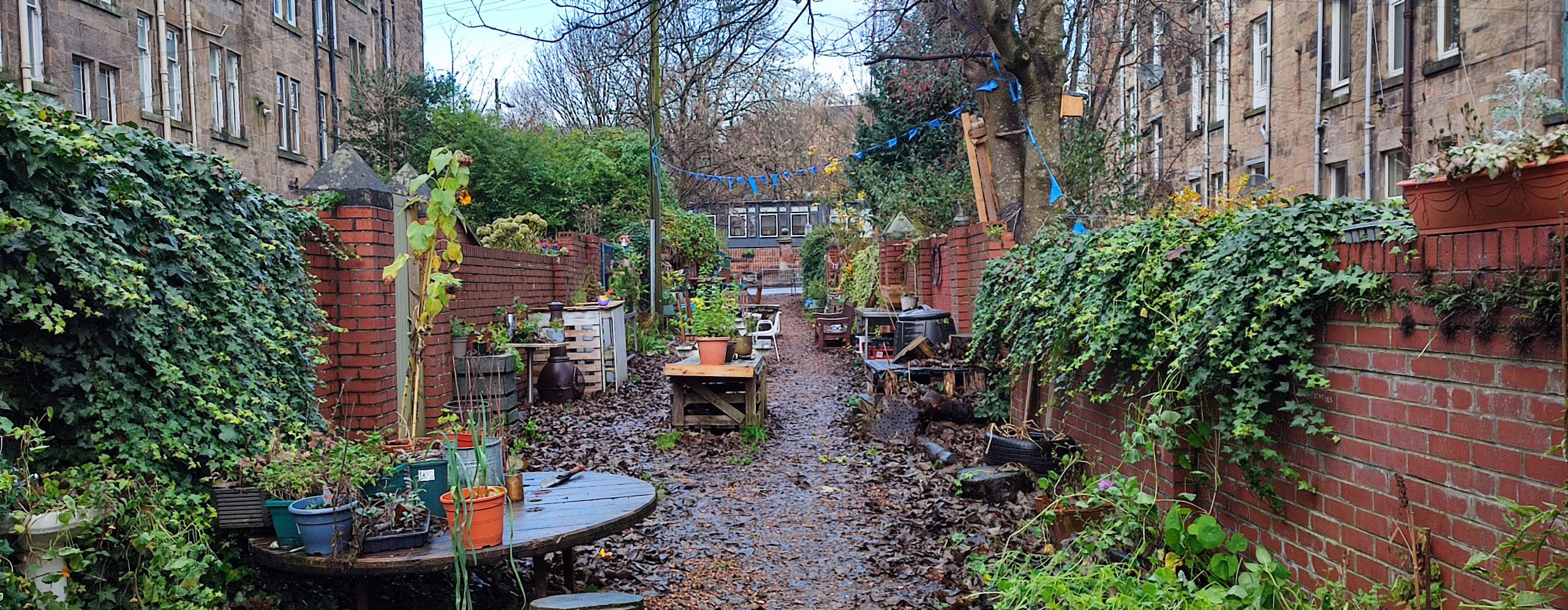
Dr Justin Marshall is a Professor of Craft and Digital Making at Northumbria University. An aspect of his work is concerned with the role and significance of digital tools within craft practice, both in terms of new aesthetic opportunities, and how the creative use of this toolset challenges the concept of the ‘handmade’. More broadly, he is interested in how craft, as a materially sensitive and human centred practice, can have value in multidisciplinary research projects that investigate areas beyond the normal scope of craft practitioners. He is currently exploring the value of bringing a craft ethos and approach to IoT through his research project; hiCraft-Crafting a Healthier Internet: People, Things and our Digital Society.
Glasgow southside
Ben Coode-Adams, Giuseppe Salvia and I visited Deirdre Nelson on her home patch at the end of November for an intensive 2 day tour of some (a lot!) of the projects, spaces and groups that she had captured through her amazing ‘Map your commons’ project produced for the ‘We are Commoners’ exhibition.
South Glasgow seems particularly rich in the range of social enterprises and charities that undertake valuable work that connect with local needs, while also talking to wider national and global concerns (e.g. ecology, sustainability, equality, equity, empowerment, social deprivation). I did wonder whether this area has unique, or at least very particular, characteristics that provide the conditions for such activities. Or does it take the likes of Deirdre to get under the skin of an area and take the time to map social assets, so revealing the richness of a geographical area beyond its physical and commercial assets? This kind of community asset mapping has been championed by the likes of Nick Gant based at the University of Brighton in the ongoing Community21 Project, and has helped lay foundations for a broad range of social and sustainable design projects.
In our tour we visited a number of social enterprises that focused on issues of sustainability. For example, the Rags to Riches reuses donated materials to create some elegant design products and runs workshops to empower people to reconsider the value of materials through creativity and skills acquisition. Their facilities included tools and equipment for working with textiles, wood and plastics. Most intriguing and unusual in this context was their low volume injection moulding set up. This appropriation of a process that is synonymous with mass production (and was the process by which the majority of the donated plastic products were originally manufactured) seems both appropriate on a practical front and in some way productively radical; they take the material and process that has been a cornerstone of global manufacturing and turn it local. They are at early stages dealing with technical challenges, but the next step for me would be to use this facility to turn the plastic waste from individualised consumption into things of community value and common good.
Left to right, top to bottom: Deep end, home of ‘Rags to Riches’- reusing donated plastic, wood and textiles; Pelleted plastics made from donated plastic bottles, toys, storage etc.; Jesmonite and plastic products; Small scale injection moulder; Donated textiles; Aprons created from donated printed promotional campaign fabrics
The Pram Project revamps prams, some of which are sold to generate revenue that then supports pram donation to those in need within the local community, mimicking the bike recycling enterprises that have proved so successful across the UK. The volume of prams donated and recovered over the last year was surprisingly large, along with the good condition that most were in, making them fit for purpose principally involved cleaning and low-level maintenance and repair. One challenge that the staff recognised is the stigma and emotional reaction to used baby related products. Whereas bikes do not seem to have the same emotional trigger, and both bargain hunting and virtue signalling (I am guilty of both!) allow the bike recycling model to prosper. While we were all impressed by the potential of this project, it did provide a lens on the tensions between communal and the personal; the easily quantified financial and environmental benefits, with the less definable (but powerful and instinctual) wish to protect and provide ‘the best’ for individuals closest to us.
Left to right: The Pram Project; Lots and Lots of donated prams!
On our last day we had lunch at the Milk Cafe, a social enterprise set up to empower and support refugee and migrant women living in Glasgow. The café aims to provide a safe and welcoming environment that promotes integration within the community. It was a very good lunch, but we could not help aligning their ‘open door’ ethos with their entrance door that could be easily opened, but then could not be shut without extreme effort (Ben, the most technically adept of our group, put this down to a faulty spring). On a cold autumn day, this led to continual door-based communications and good-natured frustrations; if you don’t want to be part of a commons that’s fine, but please close the door behind you, it stops the chill winds of global consumerism blowing through and making everyone uncomfortable.
We visited several other social enterprises that supported creativity and helped community cohesion, but whether they fitted into a definition of commoning that we could all share was unresolved.
‘Our Lane’ project
For me the most valuable thing we experienced, in relation to reflecting on the commons and what might constitute crafting the commons, was the use of shared outdoor spaces. As described in Ben’s post, the ‘Our Lane’ project is based in a lane at the back of two tenement streets that was intended to be used for rubbish collection, but this was never implemented. Residents have self-organised and occupied this space which is now used for a diversity of community events, growing things and socialising. It is an open to all with no signage that suggests ownership or access restrictions, and it is used by both residents and other community members alike. For example, the local school children regularly use it as a cut through on their way back and to school. Local materials and resources are found or donated (the ubiquitous pallet, old baths, logs, chairs ect) have been repurposed for outdoor furniture, raised beds and ponds. People use and care for different aspects according to their particular skills and interests (e.g. Deirdre, being a keen gardener, so has contributed most to this aspect).
The Lane has also provided a space and context for community support for those with greater needs or personal challenges. An example being the new extra-wide gate that a resident made and fitted linking their garden to the Lane (this should have been undertaken by the tenement management services) so that another nearby flat owner with mobility issues could get their mobility scooter into the lane and participate in events and activities. There is no explicit measure or expectation of an individual’s contribution in terms of time, effort, expertise, or money. There is no committee that officially oversees and regulates works and activities, things happen and appear organically, for good and sometimes perhaps, not so good. It would be wrong to suggest that that every resident gains pleasure from everything that goes on and has been installed in the lane, but broadly it seemed cared about, and for, by the people that use it. Though a damp late autumn day is never a good time to assess the benefits and visual appeal of any green spaces, the lane still retained a bit of the atmosphere it would have had in peak growing season. There was no sign of vandalism or deliberate misuse of the things that people had spent time and effort making and growing to create a living and lived in space.
Top to bottom, left to right: ‘Our Lane’ project; details of repurposing DIY planting projects
In contrast, a nearby community of residents have kept the lane for its original purpose, i.e. for bin storage. Like in the ‘Our Lane’ project, a community came together to make something happen that was of shared benefit. They also gained grant funding to have contractors install paving, gates and signage at either end of the lane, so creating a closed, safe and tidy (sterile) space for their bins and maximised their garden spaces. So, what they lost in communal space, and communication/socialisation, they gained in privacy and personal space.
Shared ‘Bin Lane’
These contrasting responses to the opportunities for the use of a shared space, almost in sight of each other, provided the perfect opportunity for us to reflect on communal action and commoning; what we expect it to look like and feel like. It also made me think about what sorts of processes, actions and outcomes could be aligned with a craft ethos rather than a design (predominantly industrial/product) mindset, in the context of commoning, and more generally. I have set these out in the table below. I recognise this rigid layout oversimplifies the relations (and interrelations) between craft and design, and not all design or craft activities and thinking fit neatly into these pigeonholes. However, design, with its seemingly ever-burgeoning set of prefixes, has been co-opted into addressing an increasingly wide set of challenges and problems over the last decade; it has not lacked presence or status! So, by highlighting characteristics craft can champion as their own, I am seeking to fly a humbler flag for the relevance and value craft, as both ethos and practice, in this context and more widely.
| ‘Our Lane’ – A craft ethos? | ‘Bin Lane’ – A design approach? |
| Goals change through an engagement with resources (incl. people and materials) and processes over time. They evolve. | End goals are static, and processes are merely a way of reaching predetermined finishing points. (In this case a secure and efficient bin storage space). |
| Materials-to-hand are privileged (in this case pallets, logs, baths etc.) and outcomes are refined and defined by what is available locally. | Material specification is defined by utility and performance (in this case galvanised steel and cast concrete) and sourced from wherever provides best value. |
| The process of making is recognised as a creative and valuable part of bringing something into being, not just a means to an end. (In this case residents creating their own furniture, planters and other items gives a sense of personal ownership and investment in the space). | Actual production and installation can be outsourced to manufacturers and contractors. They play no part in the creative design process and have only an instrumental role. (In this case industrially manufactured gates and pavers, installed by contractors). |
| Relinquishing some control over the materials you work with and recognising that you cannot fully control them anyway. (In this case the use of natural materials with unique characteristics, e.g. logs, recycled materials etc.) | Aim to control material characteristics to ensure reliability and consistency of outcome. (In this case galvanised steel and cast concrete).
|
| Tastes and aesthetics are diverse. Bespoke and individualised interventions can create a tapestry, the whole is bigger and richer than the parts. (In this case diversity is created by many individuals contributing specific things to the lane). | Considered design, uniformity and standardisation provides a baseline for everyone. (In this case standard pavers laid to a standard pattern across the whole length of the lane). |
| Relinquishing some control over the spaces/contexts you work in and recognising that you cannot fully control them anyway.
(In this case keeping the lane open to all to use, whether they have directly contributed or not, with the risk this entails). |
Limit access to spaces (and the benefits this affords) to a defined group who have directly contributed to its creation. (In this case having locked metal gates that clearly define the boundaries of the space and control access.) |
| There is a recognition and valuing of skills amongst all those who contribute to a project; expertise can be distributed amongst the amateur and professional. | Expertise (and power) is concentrated in the professional. |
| Care is embodied in things through skilled and care-full making and made manifest in the way they are used. | Care is defined by quality control, a maintenance contract and/or a product guarantee. |
For me the ‘Our Lane’ project encapsulates many of the benefits and tensions that commoning embodies. This open shared communal space provides pleasure and meaning for many residents, but not all. It relies on contribution that is measured in skills, time and enthusiasm rather than in financial terms. It self regulates with no officially agreed management structure, but individuals who contribute more hold more power in shaping its development. It provides a space for self-expression with no ‘permissions’ process, resulting in a diversity of outcomes some of which can sit uncomfortably with others. Involvement in its upkeep is voluntary and unconditional, so some users may benefit more than they contribute. There is no overarching agreed plan for maintenance so entropy can take hold. It is open to all with all the benefits and risks this entails. For all these tensions, as a utopian (sometimes) craftsperson, given a choice between a tidy bin lane and ‘Our Lane’ I know which one I would rather live next to.


